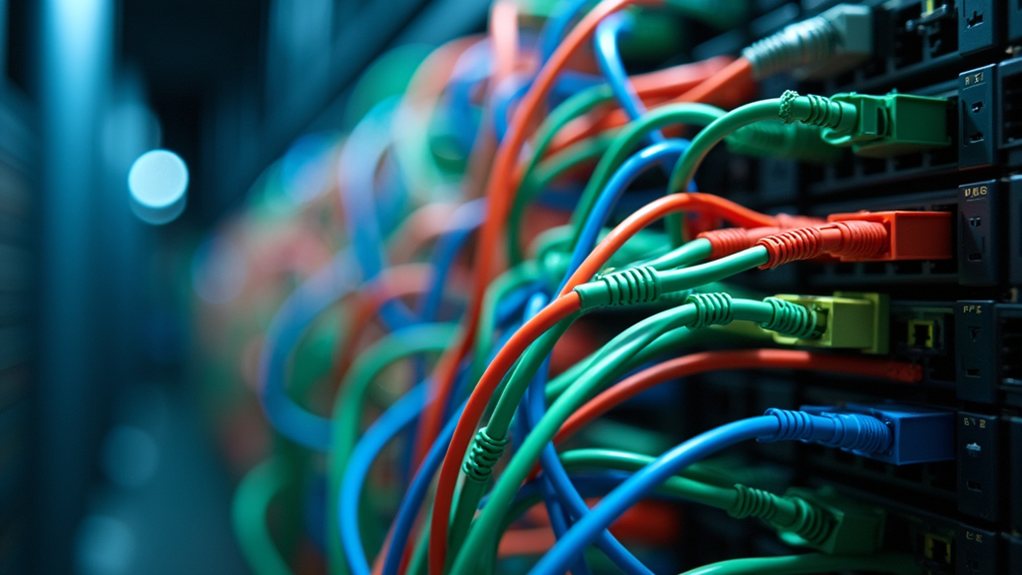Network congestion happens when too much data tries to move through a network at once. Like cars in a traffic jam, digital information slows down when networks get overloaded. Users experience slower internet speeds, delayed websites, and glitchy video calls. The problem stems from insufficient bandwidth, outdated hardware, or too many users. Network managers measure and fix congestion using special tools and techniques. Proper network design and management offer solutions to these daily digital bottlenecks.

Gridlock isn't just a problem on highways—it happens on computer networks too. Network congestion occurs when too much data tries to move through a network at once, exceeding its capacity. Just like cars backing up on a busy road, digital information can get stuck in traffic jams. These digital bottlenecks happen on all types of networks, from small home systems to the global internet.
Several factors cause network congestion. Networks might simply lack enough bandwidth to handle all the traffic. Poor network design or outdated hardware can make the problem worse. The number of users connecting to a network also plays a role. When many people use bandwidth-heavy applications like video streaming or large file downloads at the same time, networks can quickly become overwhelmed.
Network congestion arises from insufficient bandwidth, poor architecture, outdated equipment, and too many users consuming high-bandwidth services simultaneously.
Users experience network congestion in various ways. Slow internet speeds and delays are the most common signs. Websites take longer to load, and online games might freeze or stutter. During video calls, voices might cut out or images might appear blocky. These issues happen because data packets get delayed or lost entirely in the congestion. For businesses, these problems can notably reduce productivity and frustrate customers. This congestion is often more noticeable during peak usage times, typically in the evenings when many households are simultaneously online.
Network managers use special tools to measure congestion. They track how much bandwidth is being used, how long it takes for data to travel, and how many packets get lost. By comparing current performance to normal baselines, they can identify when congestion becomes a problem. These measurements help them understand when and where network issues are happening.
Modern networks use several techniques to fight congestion. TCP (Transmission Control Protocol), the internet's main data transfer method, includes features that automatically slow down data transmission when congestion is detected. Network equipment can prioritize important traffic through Quality of Service settings. Some systems balance traffic across multiple paths or limit new connections during busy periods. Traffic shaping is frequently implemented as a proactive measure to control data flow and ensure consistent service quality.
Organizations can take steps to reduce network congestion. Increasing bandwidth capacity by upgrading internet connections or network hardware helps handle more traffic. Redesigning networks with better traffic flow in mind can eliminate bottlenecks. Setting up rules that prioritize critical applications guarantees important work doesn't get delayed by less urgent activities.
As our reliance on networks grows with more devices connecting every day, understanding and managing congestion becomes increasingly important. The smooth operation of everything from business communications to streaming entertainment depends on keeping digital traffic flowing freely. While network congestion can't be eliminated entirely, proper management helps minimize its impact on users.
Frequently Asked Questions
How Does Congestion Differ Between Wired and Wireless Networks?
Network congestion differs greatly between wired and wireless networks.
Wired congestion stems from bandwidth limitations, device bottlenecks, and hardware issues. Wireless congestion results from limited spectrum, signal interference, and physical obstacles.
In wired networks, congestion causes latency and buffer overflows. Wireless networks experience packet collisions and disconnections.
Wired congestion is more predictable, while wireless congestion varies due to environmental factors like weather and user density.
Can Network Congestion Affect Cybersecurity?
Network congestion can seriously impact cybersecurity.
When networks become clogged, security tools don't work properly. They may miss threats hidden in heavy traffic. During congestion, intrusion detection systems struggle to spot attacks, and security updates can't reach devices quickly.
Hackers often cause congestion deliberately through DDoS attacks.
Companies use traffic shaping and network segmentation to protect critical systems when networks get overloaded.
What Role Does Cloud Computing Play in Modern Network Congestion?
Cloud computing markedly contributes to network congestion today.
With data center traffic projected to reach 19.5 ZB yearly by 2021, networks face unprecedented strain. Cloud services require constant, reliable internet connections, competing for limited bandwidth. During peak usage times, this competition often causes slowdowns.
The growing number of connected devices—expected to exceed 50 billion by 2030—further intensifies this pressure on existing network infrastructure.
How Do ISPS Prioritize Traffic During Peak Congestion Periods?
ISPs manage peak congestion by using deep packet inspection to categorize traffic types.
They implement Quality of Service policies that give highest priority to time-sensitive applications like video calls and online gaming. Less urgent traffic such as file downloads receives lower priority.
Many ISPs also throttle heavy users and employ fair usage policies.
Some use machine learning algorithms that dynamically adjust traffic priorities based on network conditions.
What Emerging Technologies Help Reduce Network Congestion in 5G Environments?
Several new technologies are helping reduce 5G network congestion.
AI-powered systems predict traffic patterns and automatically adjust resources.
Edge computing moves data processing closer to users, cutting down delays.
Advanced antennas with beamforming target signals directly to specific devices.
Network slicing creates separate virtual networks for different services.
These innovations work together to keep data flowing smoothly, even when many people are online simultaneously.










